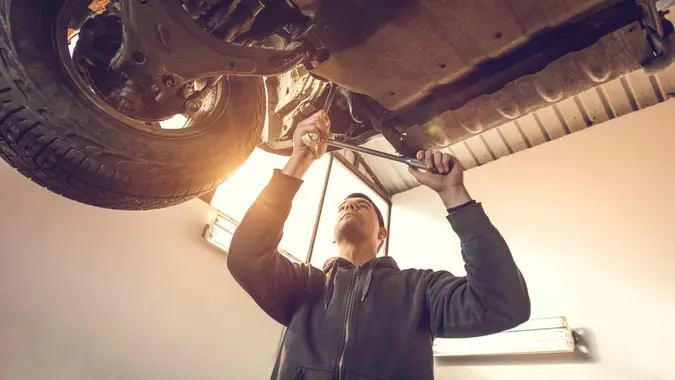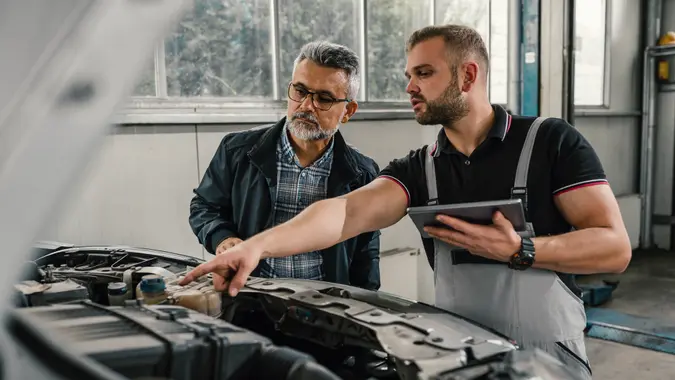How To Sell a Car Privately: Your Step-by-Step Guide

Commitment to Our Readers
GOBankingRates' editorial team is committed to bringing you unbiased reviews and information. We use data-driven methodologies to evaluate financial products and services - our reviews and ratings are not influenced by advertisers. You can read more about our editorial guidelines and our products and services review methodology.

20 Years
Helping You Live Richer

Reviewed
by Experts

Trusted by
Millions of Readers
You have a few options when it comes to selling your old car. You can:
- Trade it in and make some money off the price of your new car in exchange
- Sell to a dealership or car lot.
- Sell privately to an individual, which might get you the best price.
Here’s what you need to know about how to sell a car privately.
Why Sell Your Car Privately? What To Expect
If you sell or trade in your car to a dealer, the price will get marked up before they turn it around to sell to someone else. This means profit for the dealership. That added cost is “overhead,” and is added to the amount they paid you for the car.
If you sell your car directly, you can charge more than a dealer would pay for your car because you don’t have that overhead.
Because you will make more on the car, you have more flexibility on the price. You can choose to sell for less than what a dealer would charge. This could mean that you can sell your car more quickly.
A private car sale does require a little more work, but it could be worth it to sell your car privately if you can make a little more from it. Follow these steps:
Step 1: Determine Your Car’s Value
The first question to ask yourself is, ‘How much is my car worth?’ There are online resources that can help. Look at Kelley Blue Book, Edmunds and the National Automobile Dealers Association (NADA).
To get a fair value, you’ll need to input your car’s:
- Year
- Make
- Model
- Options
- Mileage
- Current condition
Be honest! Use all three sources and average the results to get a fair price for your car. Check your work by looking at ads for similar cars to make sure you’re in the ballpark.
Step 2: Prepare Your Car for Sale
Now that you know what price you’re going to ask for your car, it’s time to get it ready to sell. There are a few things you can do to make it more attractive to a buyer.
Clean and Detail
Clean and detail your car’s interior and exterior. You may want to pay for professional detailing, but you’ll also want to look the vehicle over yourself. Look for any chips in the paint, scrapes or other minor blemishes you can buff out or touch up.
Repairs
See if there are any minor repairs it makes sense to fix before you sell. A mechanic can look it over and advise you on what to fix and what to leave alone. You want to do repairs that are low cost but have a high impact.
Maintenance Records
Collect your maintenance records, so prospective buyers can see that you’ve regularly maintained your vehicle. If you’ve recently replaced things like tires or brakes, make sure you can document that.
Use High-Quality Photos
Take high-quality, well-lit photos of your car from several different angles. Show the outside and the inside, particularly the dashboard. Don’t forget to take a picture of the odometer.
Step 3: Create a Compelling Listing
Now it’s time to write your car’s listing. You’ll want to include all the information that makes it easy for someone to want to choose your car.
Be honest and transparent about your car’s condition. If you advertise it as “mint condition,” and it’s not, you’ll see plenty of prospects, but far more disappointments than actual buyers.
What Else To Include in Your Listing
Price: This is your purchase price.
Price Flexibility
Be clear if you’re willing to budge on price. You can mention one of these, depending on how you’d like to handle the sale.
- Firm: You’re not open to negotiation.
- Negotiable: You are willing to negotiate.
- Best offer accepted: You’re willing to sell quickly, though you may get some lowball requests.
Advertise your listing on auto resale sites like AutoTrader or CarGurus, on online marketplaces, like Craigslist and Facebook Marketplace, and in local classified ads.
Step 4: Communicate with Potential Buyers and Schedule Test Drives
If you’ve priced your vehicle right and written a compelling listing, you should start getting contacted by potential buyers. Here’s what to do next:
Respond Quickly
When someone reaches out to you, respond promptly and professionally. They may have questions, which you should answer to the best of your ability. Then they may want to drive the car.
Test Drive
There are some safety precautions you should take when allowing prospective buyers to test drive your car. Schedule the test drive in a public place, during daylight hours. Bring someone with you, and expect that the buyer will do the same.
Safety and Precautions
When you get to the test drive location, take a picture of the potential buyer’s driver’s license. Go with them on the test drive and make sure they stay in populated areas that you know. A test drive shouldn’t need to last longer than 10 or 15 minutes.
Step 5: Negotiate the Sale
If the buyer likes the car after driving it, they may make you an offer. They may also ask for time to think about it. That’s fine, but let them know that if you get an offer in the meantime, you’ll take it.
You should have a price in mind below which you will not go. This makes it easy to evaluate any offer you may get. If it’s within your limits, you can accept on the spot. If not, you can tell them your bottom-line price and see if they’ll meet it.
Be prepared to walk away if the buyer isn’t willing to meet your low-end limit.
Step 6: Payment and Paperwork
Handling the payment and the paperwork needed to transfer ownership is the trickiest part of selling a car privately. If you understand what’s needed, though, and take some common-sense steps to protect yourself, you’ll be golden.
Secure Payment Options
Only accept a secure method of payment. That means a cashier’s check, which you should verify with the issuing bank, a wire transfer or an escrow service. Avoid using cash if the amount is more than one or two thousand dollars.
If the buyer is taking out a loan to finance their purchase of your car, the lender should give them a cashier’s check for the purchase price, made out to you. Again, verify the check with the issuing financial institution.
Once you have verified that the payment is in order, it’s time to transfer the ownership of your car to the buyer. You’ll need:
- The vehicle’s title, signed by you.
- A bill of sale, indicating the purchase price.
- A release of liability — check your state’s requirements for this.
- The odometer disclosure statement.
- A lien release, if applicable.
How To Sell a Car With a Loan
If you still have a loan on your car, that’s an extra step. Here’s what to do:
- Contact your lender and explain that you’re selling the vehicle
- The lender will give you a payoff amount that will pay the loan off completely.
- The lender will send you the title and the lien release.
- If you’re not able to pay off the loan in full immediately, your lender may be able to recommend a third-party service that can help.
Step 7: Post-Sale Responsibilities
You’re almost there! There are a few things you can do once the sale goes through:
- Remove your license plates from the vehicle. A buyer should have their own plates to put on the car.
- Cancel the insurance on the sold vehicle by contacting your insurance company.
- Take the plates and your bill of sale to the DMV.
- The DMV can then record the sale and cancel your registration of the vehicle.
Quick Tips
Here are some quick tips on how to sell a car fast.
- Price it right: If you want the car out of your driveway quickly, list it for slightly below similar vehicles. That way, yours will be the first one people want to look at.
- Be flexible: When someone makes an offer below your asking price, consider if the difference is enough for you to want to go through more test drives. Sometimes your first offer is the best one.
- Have your info ready: Know what steps you’ll need to follow to complete the sale: get the paperwork ready, know what the DMV needs and so forth.
- Know what to expect: Selling a car privately can be a great way to get more for your vehicle. It doesn’t have to be overwhelming if you know what to expect.
Our in-house research team and on-site financial experts work together to create content that’s accurate, impartial, and up to date. We fact-check every single statistic, quote and fact using trusted primary resources to make sure the information we provide is correct. You can learn more about GOBankingRates’ processes and standards in our editorial policy.
- Kelley Blue Book. "Kelley Blue Book."
- Edmunds. "Edmunds."
- NADA. "Consumer Vehicle Values."
 Written by
Written by  Edited by
Edited by 

























